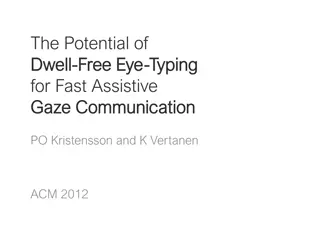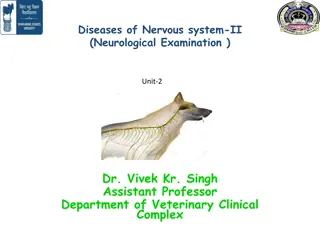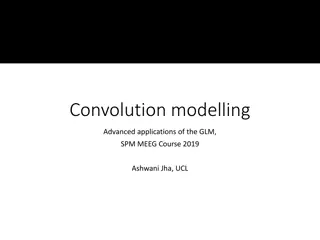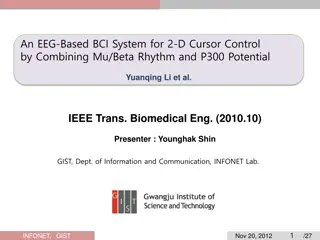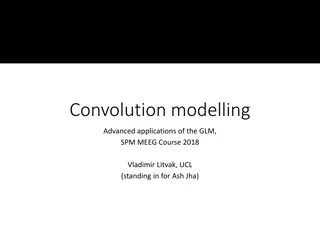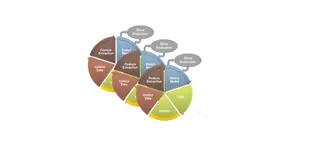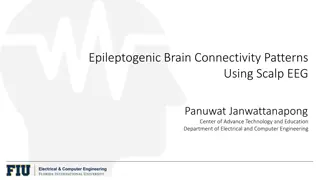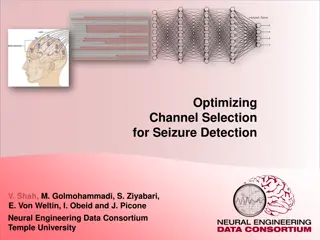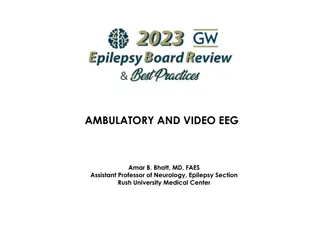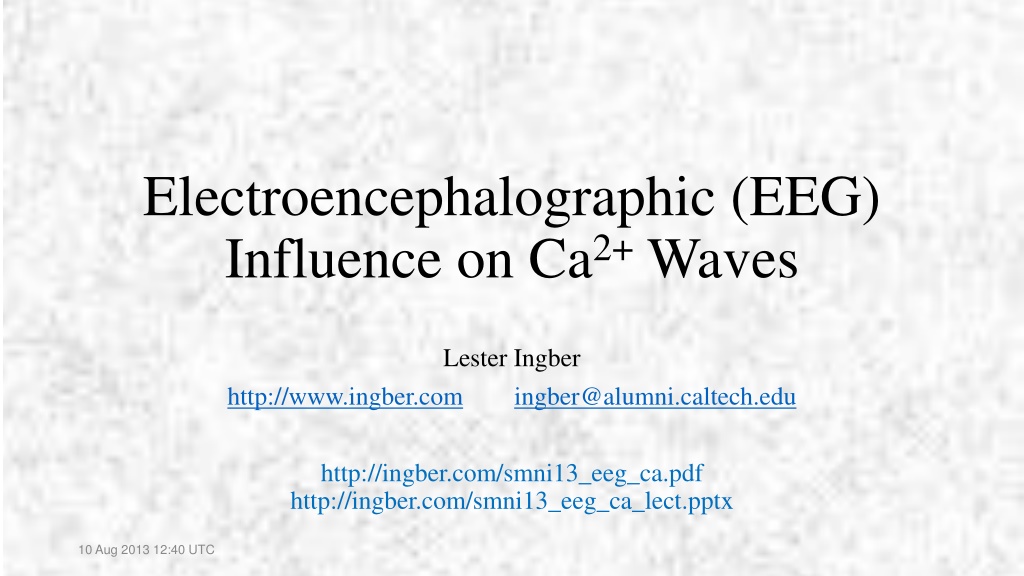
Neocortical Interactions and EEG Influence Study
Delve into the intricate relationships between electroencephalographic (EEG) patterns and Ca2+ waves in the brain, exploring scales of neocortical interactions, synaptic mechanisms, and statistical mechanics. This study by Lester Ingber provides insights into the molecular and quantum scales of neural activity, addressing interactions from the largest scalp EEG scale to the smallest Ca2+ scale, shedding light on short-term memory processes and neuronal dynamics.
Download Presentation

Please find below an Image/Link to download the presentation.
The content on the website is provided AS IS for your information and personal use only. It may not be sold, licensed, or shared on other websites without obtaining consent from the author. If you encounter any issues during the download, it is possible that the publisher has removed the file from their server.
You are allowed to download the files provided on this website for personal or commercial use, subject to the condition that they are used lawfully. All files are the property of their respective owners.
The content on the website is provided AS IS for your information and personal use only. It may not be sold, licensed, or shared on other websites without obtaining consent from the author.
E N D
Presentation Transcript
Electroencephalographic (EEG) Influence on Ca2+Waves Lester Ingber http://www.ingber.com http://www.ingber.com ingber@alumni.caltech.edu ingber@alumni.caltech.edu http://ingber.com/smni13_eeg_ca.pdf http://ingber.com/smni13_eeg_ca_lect.pptx 10 Aug 2013 12:40 UTC
Table of Contents Scales of Neocortical Interactions p + qA Interactions A-Model Fits to EEG Computational Algorithms Outlook http://ingber.com/smni13_eeg_ca.pdf http://ingber.com/smni13_eeg_ca_lect.pptx 2
Scales of Neocortical Interactions http://ingber.com/smni13_eeg_ca.pdf http://ingber.com/smni13_eeg_ca_lect.pptx 3
Neuronal Scales of Neocortical Interactions http://ingber.com/smni13_eeg_ca.pdf http://ingber.com/smni13_eeg_ca_lect.pptx 4
Interactions Among Scales Include molecular and quantum scales Ca2+ ions Research into interactions across multiple scales Interactions between the largest scalp EEG scale and the smallest Ca2+ scale? http://ingber.com/smni13_eeg_ca.pdf http://ingber.com/smni13_eeg_ca_lect.pptx 5
SMNI Statistical Mechanics of Neocortical Interactions (SMNI) Progression of aggregation of probability distributions Synaptic interactions via quantal transmissions Neuron-neuron interactions across minicolumns & macrocolumns Minicolumn of hundreds of neurons Macrocolumn of thousands of minicolumns Macrocolumnar aggregation to regions (scalp EEG scales) Region of thousands of macrocolumns About 15-20 billion neurons in cerebral cortex http://ingber.com/smni13_eeg_ca.pdf http://ingber.com/smni13_eeg_ca_lect.pptx 6
SMNI Successes Short-term memory (STM) STM duration and stability STM capacity rules of 7 2 (auditory) and 4 2 (visual) STM primacy versus recency rule (first > last > middle) Hick s law: g-factor linear time to access sets of STM Rate of minicolumnar information diffusion (nearest neighbors) Short-ranged unmyelinated within epochs of long-ranged myelinated fibers Scaled up to fit scalp EEG data http://ingber.com/smni13_eeg_ca.pdf http://ingber.com/smni13_eeg_ca_lect.pptx 7
Coding of Neuronal Information Firing patterns among neurons Assumed by SMNI since 1980 Recent experimental confirmation Synfire synchronized firings in laminae Others Astrocytes (a class of glial cells) Paramagnetic and diamagnetic encoding Quantum-mechanical encoding in microtubules http://ingber.com/smni13_eeg_ca.pdf http://ingber.com/smni13_eeg_ca_lect.pptx 8
Tripartite Neuron-Astrocyte-Neuron Astrocyte Important class of glial cells Nourish neurons Major source of Ca2+ waves (includes free unbuffered ions) Up to tens of thousands of free ions/wave Concentrations up to 5 M ( M = 10 3 mol/m3) Range up to 250 m speed 50 100 m/s Influence Glutamate quantal (integral units) concentrations in synaptic gaps Primary excitatory neurotransmitter depolarizes and excites neurons http://ingber.com/smni13_eeg_ca.pdf http://ingber.com/smni13_eeg_ca_lect.pptx 9
p + qA Interactions http://ingber.com/smni13_eeg_ca.pdf http://ingber.com/smni13_eeg_ca_lect.pptx 10
Regional Magnetic Vector Potential A Regional Scales Neocortical current I due to coherent synchronized firings Observed values includes all theoretical screening, etc. Wire model of minicolumns fit to I has log dependence on r Magnetic vector potential A I http://ingber.com/smni13_eeg_ca.pdf http://ingber.com/smni13_eeg_ca_lect.pptx 11
Molecular Ca2+ Wave Consider only sources from regenerative processes from internal stores Process involves Ca2+ released from IP3R acting on other IP3R sites Process requires or affects other processes, e.g., IP3, mGluR, mAChR, etc. Momentum of Ca2+ ions in wave with mean p |p| = 10 30 kg-m/s |p| < |qA| = 10 28 kg-m/s q = -2 e where e = -1.6 10 19 C (charge of electron) Duration of a wave up to 500 ms http://ingber.com/smni13_eeg_ca.pdf http://ingber.com/smni13_eeg_ca_lect.pptx 12
p + qA Interaction Canonical momentum = p + qA Established in both classical and quantum physics Classical comparison of magnitudes of molecular p and regional qA Quantum treatment of p + qA for wave packet in p-space SI units (p + q/cA in Gaussian units, c = light speed) Many-body p effects not yet considered http://ingber.com/smni13_eeg_ca.pdf http://ingber.com/smni13_eeg_ca_lect.pptx 13
p + qAp-Space Wave Function http://ingber.com/smni13_eeg_ca.pdf http://ingber.com/smni13_eeg_ca_lect.pptx 14
p + qAr-Space Wave Function http://ingber.com/smni13_eeg_ca.pdf http://ingber.com/smni13_eeg_ca_lect.pptx 15
Quantum Effects in r-Space Influences real part of wave function in r-space Not Aharonov-Bohm effect (phase of ) Note r r qAt / m If persisted100 ms displacement of 10 3 m = mm (macrocolumn) Synaptic extent (not gap ~ nm) ~ 104 ( = 10 10 m) = m http://ingber.com/smni13_eeg_ca.pdf http://ingber.com/smni13_eeg_ca_lect.pptx 16
Possible Long Time Quantum Coherence Several examples of extended quantum coherence in wet media Bang-bang (BB) kicks or quantum Zeno effect (QZE) A mechanism sometimes used in quantum computation http://ingber.com/smni13_eeg_ca.pdf http://ingber.com/smni13_eeg_ca_lect.pptx 17
Classical and/or Quantum Effects Alignment of Ca2+ waves along A || I A influence on regional-averaged synaptic quantal transmissions Ca2+ waves influence quantal transmissions influencing background B A affects p ofCa2+ waves A therefore affects background synaptic activity http://ingber.com/smni13_eeg_ca.pdf http://ingber.com/smni13_eeg_ca_lect.pptx 18
SMNI Fits to EEG http://ingber.com/smni13_eeg_ca.pdf http://ingber.com/smni13_eeg_ca_lect.pptx 19
Fits to EEG to Test A Influences SMNI conditional probability of firing P SMNI Lagrangian L function of firings M(t) All parameters taken within experimentally observed ranges SMNI threshold factor F argument of nonlinear means and covariance Minicolumnar-averaged quantal means and variances of synaptic interactions Scales of application of Lagrangian STM mesocolumn (converge to minicolumn; diverge to macrocolumn) Mesocolumn of excitatory E and inhibitory I firings Trough of minima permit centering mechanism (CM) Scaling SMNI to scale of scalp EEG http://ingber.com/smni13_eeg_ca.pdf http://ingber.com/smni13_eeg_ca_lect.pptx 20
SMNI Lagrangian http://ingber.com/smni13_eeg_ca.pdf http://ingber.com/smni13_eeg_ca_lect.pptx 21
Intuitive Lagrangian L of Firings M http://ingber.com/smni13_eeg_ca.pdf http://ingber.com/smni13_eeg_ca_lect.pptx 22
SMNI Threshold Factor http://ingber.com/smni13_eeg_ca.pdf http://ingber.com/smni13_eeg_ca_lect.pptx 23
Centering Mechanism (CM) Shift background noise B in synaptic interactions Shifts are consistent with experimental observations of selective attention Shift B to keep F M (no constant offset) Minima typically driven to small values of AEE ME - AIE MI Defines trough along line in M firing space Maximizes number of minima within firing boundaries STM firing patterns appear within a sea of noise http://ingber.com/smni13_eeg_ca.pdf http://ingber.com/smni13_eeg_ca_lect.pptx 24
PATHINT STM With CM http://ingber.com/smni13_eeg_ca.pdf http://ingber.com/smni13_eeg_ca_lect.pptx 25
Dependence of Synaptic Background B on A Quantal mean of mesocolumnar average a = A + B A is coefficient of firings Bis background noise Influenced by astrocytes Ca2+ waves Model A influence as B = B0 + B1|A| A I is EEG electric potential at previous t for these fits A model requires Dynamic Centering Mechanism (DCM) at each t http://ingber.com/smni13_eeg_ca.pdf http://ingber.com/smni13_eeg_ca_lect.pptx 26
Preliminary Results EEG Data: http://kdd.ics.uci.edu/databases/eeg/ Collected by Henri Begleiter in large NIH alcoholism study Entered into KDD database by Lester Ingber in 1997 Knowledge Discovery in Databases merged with http://archive.ics.uci.edu/ml/ Paradigms to test attentional states during P300 events Train in-sample to L and test out-of-sample Sensitive Canonical Momenta Indicators (CMI) A model has stronger signal than no-A model similar to aggregated data over 11,075 runs http://ingber.com/smni13_eeg_ca.pdf http://ingber.com/smni13_eeg_ca_lect.pptx 27
Histograms of Control and Alcoholic Data http://ingber.com/smni13_eeg_ca.pdf http://ingber.com/smni13_eeg_ca_lect.pptx 28
A Versus No-A Models A model No-A model http://ingber.com/smni13_eeg_ca.pdf http://ingber.com/smni13_eeg_ca_lect.pptx 29
Supplementary Analysis Marco Pappalepore and Ronald Stesiak Overall, mixed results were demonstrated when evaluating the efficacy or improvements of the CMI when comparing to the EEG data. However, many definitively positive improvements with the A model were observed, both when comparing to the EEG data and the no-A model. See http://ingber.com/smni13_eeg_ca_supp.zip http://ingber.com/smni13_eeg_ca.pdf http://ingber.com/smni13_eeg_ca_lect.pptx 30
Computational Algorithms http://ingber.com/smni13_eeg_ca.pdf http://ingber.com/smni13_eeg_ca_lect.pptx 31
Adaptive Simulated Annealing (ASA) http://www.ingber.com http://alumni.caltech.edu/~ingber http://asa-caltech.sourceforge.net https://code.google.com/p/adaptive-simulated-annealing C-language importance-sampling for global fit over D-dimensional space. ASA annealing temperature exponentially decreasing T schedule Faster than fast Cauchy annealing with polynomial decreasing T schedule Much faster than Boltzmann annealing with logarithmic decreasing schedule Over 100 OPTIONS provide robust tuning since 1989 (VFSR ASA) ASA_PARALLEL OPTIONS hooks developed as PI 1994 NSF PSC project ASA currently used as PI of NSF XSEDE projects. http://ingber.com/smni13_eeg_ca.pdf http://ingber.com/smni13_eeg_ca_lect.pptx 32
PATHINT & PATHTREE Time path-integral of short-time conditional multivariate probability PATHINT parallel hooks developed as PI 1994 NSF PSC project PATHINT PATHTREE is fast accurate binomial tree Natural metric of the space is used to lay down the mesh Short-time probability density accurate to ( t 3/2) Tested in finance, neuroscience, combat analyses, and selected nonlinear multivariate systems PATHTREE used extensively to price financial options http://ingber.com/smni13_eeg_ca.pdf http://ingber.com/smni13_eeg_ca_lect.pptx 33
Calculations on XSEDE.org Adaptive Simulated Annealing (ASA) fit SMNI to EEG data 6 CPU-hrs for each of 120 train-test runs = cumulative CPU-month+ 6 CPU-hrs for all runs on XSEDE in parallel NSF Extreme Science & Engineering Discovery Environment http://ingber.com/smni13_eeg_ca.pdf http://ingber.com/smni13_eeg_ca_lect.pptx 34
Outlook http://ingber.com/smni13_eeg_ca.pdf http://ingber.com/smni13_eeg_ca_lect.pptx 35
Tentative Conclusions Top-down interactions Regional coherent firings Selective Attention Attention Consciousness Attention influences molecular scales via p + qA Certainly in domain of classical physics Possibly in domain of quantum physics SMNI support for p + qA interactionsat tripartite synapses DCM control of background synaptic activity B Control of STM during states of selective attention http://ingber.com/smni13_eeg_ca.pdf http://ingber.com/smni13_eeg_ca_lect.pptx 36
Future Research Tripartite models that influence synaptic background B Test models of A influences on B by fits to EEG data Coherence times for beams of Ca2+ waves PATHINT and PATHTREE codes Volunteers welcome on XSEDE.org platforms http://ingber.com/lir_computational_physics_group.html http://ingber.com/smni13_eeg_ca.pdf http://ingber.com/smni13_eeg_ca_lect.pptx 37
Acknowledgments National Science Foundation NSF.gov Extreme Science & Engineering Discovery Environment XSEDE.org http://ingber.com/smni13_eeg_ca.pdf http://ingber.com/smni13_eeg_ca_lect.pptx 38
Lester Ingber Published over 100 papers and books in: theoretical nuclear physics, neuroscience, finance, optimization, combat analysis, karate, and education. http://ingber.com/smni13_eeg_ca.pdf http://ingber.com/smni13_eeg_ca_lect.pptx 39










